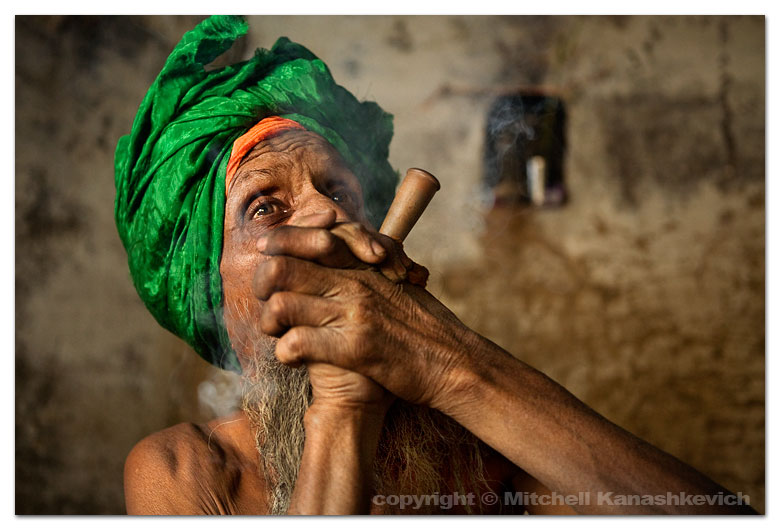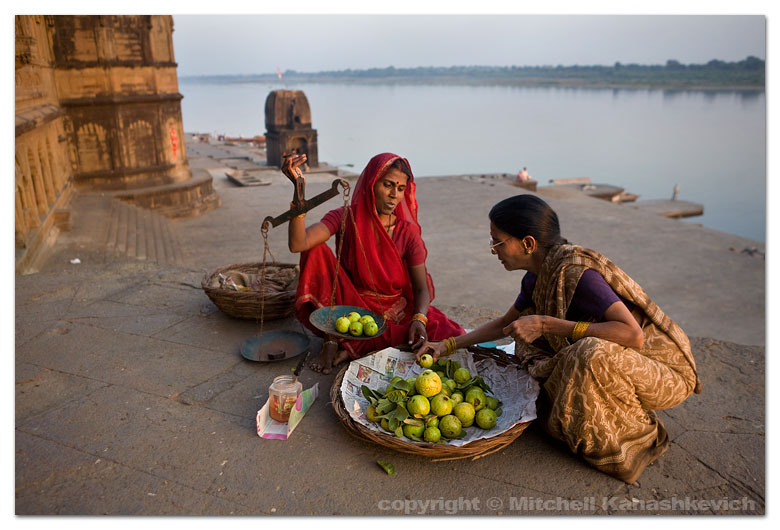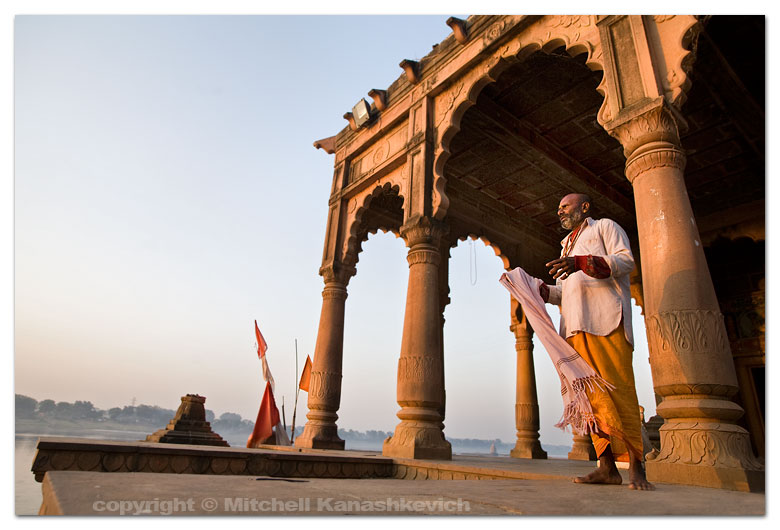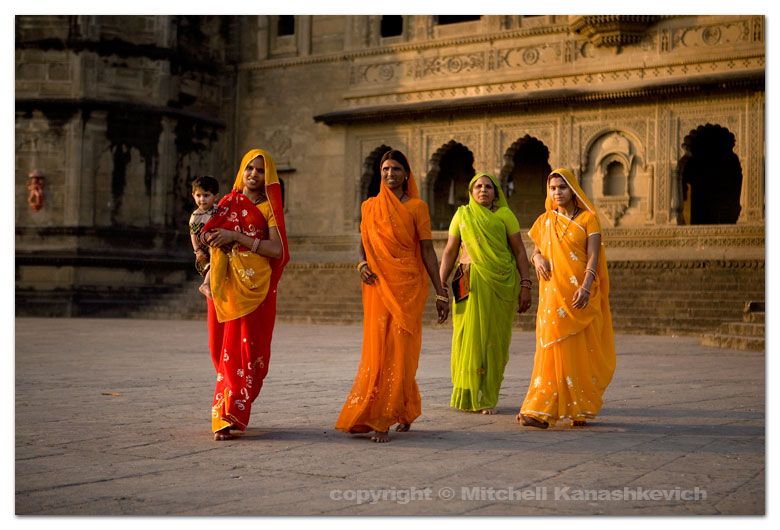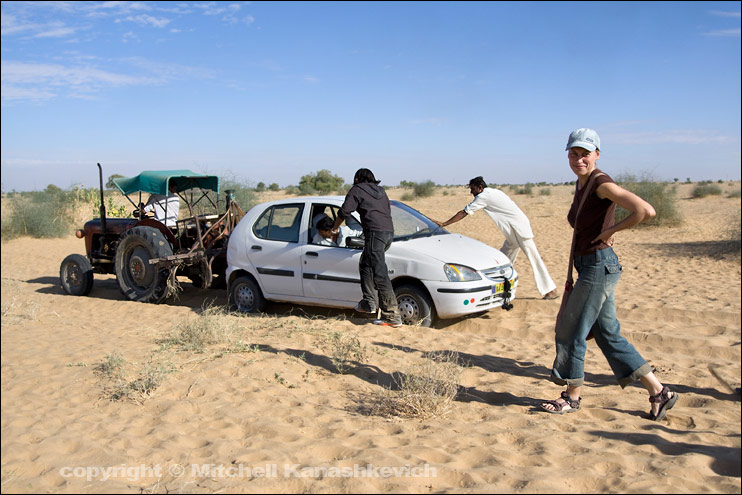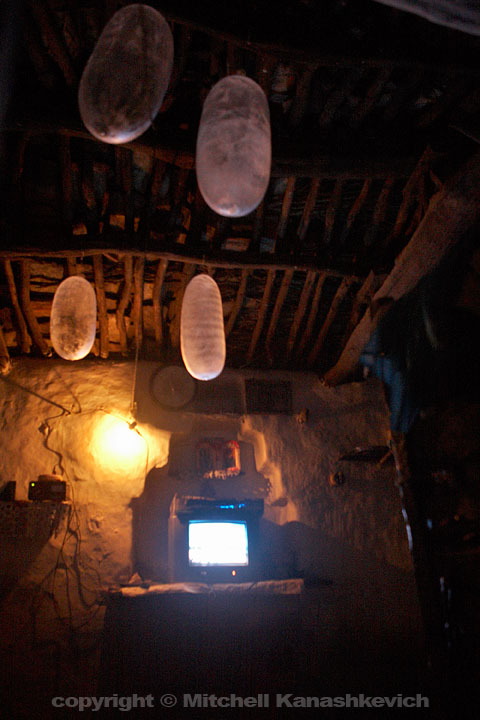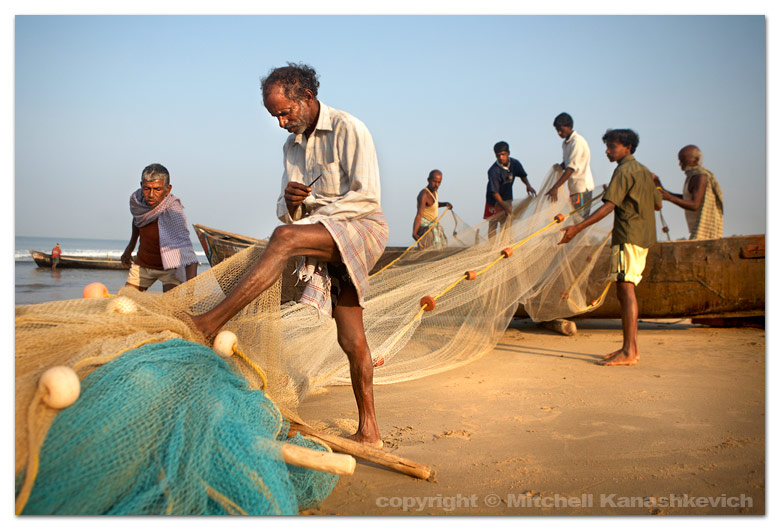 Yes, my first blog entry for 2009 is well over due, but we are on the road after all and we are exhausted. Yesterday we finally arrived in "God's Own Country" - Kerala. We watched sunset from the beach, but I was so tired that I fell asleep right there on the sand. We are already around 2000km from Bundi - the place where we started our motorcycle journey. The way from Goa to Kerala isn't so long, but it has been more tiring than our other journeys. National Highway 17 is going into my books as one of the crappiest major roads in India, albeit one of the more beautiful.
Our New Year's Eve was one of the best I've had, ever. In Arambol, Goa Tanya and I became friends with a girl from Moscow who shared our, well more like my craze for seafood. She joined in our plan to buy seafood for cheap at the fish market and cook it by the fire on the beach on New Year's Eve. The evening went even better than planned; we somehow managed to find an empty beach, lit a fire and cooked our gigantic prawns and an equally gigantic crab. Of course being really far from the action in Goa is impossible and so we were treated to a few rounds of fireworks from the neighboring beaches.
Yes, my first blog entry for 2009 is well over due, but we are on the road after all and we are exhausted. Yesterday we finally arrived in "God's Own Country" - Kerala. We watched sunset from the beach, but I was so tired that I fell asleep right there on the sand. We are already around 2000km from Bundi - the place where we started our motorcycle journey. The way from Goa to Kerala isn't so long, but it has been more tiring than our other journeys. National Highway 17 is going into my books as one of the crappiest major roads in India, albeit one of the more beautiful.
Our New Year's Eve was one of the best I've had, ever. In Arambol, Goa Tanya and I became friends with a girl from Moscow who shared our, well more like my craze for seafood. She joined in our plan to buy seafood for cheap at the fish market and cook it by the fire on the beach on New Year's Eve. The evening went even better than planned; we somehow managed to find an empty beach, lit a fire and cooked our gigantic prawns and an equally gigantic crab. Of course being really far from the action in Goa is impossible and so we were treated to a few rounds of fireworks from the neighboring beaches.
I guess from my limited time in Goa I can say that it is indeed a different world to the rest of India. Those who don't venture outside of this tiny state would certainly get a very warped idea of what India is like. I mean where else in India could you see bikini clad European girls riding scooters? The thing is they don't even usually get stared at (at least not in Arambol). It was an absolute shock to me and Tanya at first, simply didn't make sense that this was happening in a country where the only women showing skin are Bollywood stars that can only be seen on TV and on billboards, in a country where for most part men and women do not even hold hands in public, where village women rarely unveil their faces. Perhaps the bikini girls were oblivious to that India or perhaps they had been there and had enough, it felt like this was their turf and their turn to make the rules.
There are many things that make Goa very different from the 'real' India. It's cleaner, it's richer and dare I say more open minded. This open mindedness often leads to 'progress' but just as often it destroys local cultures and ways of living. I avoided Goa over my past three trips to India because I expected to see nothing more than hoards of tourists and dreadlocked, grass smoking foreigners. In many cases that held true, but in many others it did not. The culture is still there, it's in the churches of Old Goa, the streets of Panjim, it is probably in the villages away from the coast. Given enough time before my trip ends I plan to come back and peak into Goa's quieter pockets.

Our next stop was in North Karnataka, Gokarna - a small temple town with a hippy vibe. There are no parties like those of Goa in Gokarna. It seems that the foreigners who come here come to simply chill and get an occasional sample of the local culture, which exists oblivious to the dreadlocks, bikinis and newly opened cafes with foreign menus.
Every morning beautifully dressed Brahmins (priests) can be seen going in an out of temples, pilgrims are praying, making offerings and occasionally wetting their feet in the sea, while at the North end of Gokarna beach old fishermen mend their nets and set out to make a living the same way that their forefathers have for generations. The really big draw cards of the region are the quieter, ideallyc beaches of Om and Kudle. I have only been to Om and while the amount of rubbish that covers the path down to the beach is abhorring, the beach itself is clean and very beautiful.
I wish I had unlimited time to stay longer in Gokarna, but I don't and so I had to move on after three days. On our final day in the area I had to satisfy my seafood lust once again, still joined by our friend from Moscow we bought a whole load of crabs and some prawns at the nearby fish market town of Kadidi and had the stuff barbequed for us at a beachside restaurant/shack. What a meal, the only problem or perhaps a blessing is the fact that I still can't look at seafood three days later, it will pass, I think. Our Moscow friend has joked that I should quit photography and write a guidebook for budget culinary travelers on where to find cheap food, where to have it cooked etc. Hey, might not be such a bad idea.

Right now we're in Kannur - a town in an area of North of Kerala that is famous for Theyyam - a ritualistic dance where the performer is possessed by a higher power and becomes the embodiment of a God. From the photos I've seen it's pretty colorful and amazing. This is what I'm here for. It's Theyyam season and a performance/ritual happens almost daily. I'll see my first Theyyam tomorrow.
Kerala is also India's most educated state with over 90% literacy rate. How is this manifested in everyday life? Well, more people can speak good English, that's the obvious thing that stands out. However this wouldn't be India if there were no surprises. This evening we visited a fort built by the Portuguese in the 1500s. At the entrance sat a man, a simple looking mustached fellow with a badge "Tourist Police" on the left side of his shirt.
I had always thought that the caretakers/tourist police or whoever sits at the entrance of monuments are just there to fill a spot, to get paid a nominal wage because they do not have the qualifications to do much else. Boy was I wrong and I realized it as soon as the "Tourist Policeman" opened his mouth. In very good English he started to tell me in great detail about the fort. But that wasn't the surprise. Suddenly the man said - "Two years ago I had a book published about the history of this fort." - "Really?" - "Yes" I still found it slightly hard to believe until I saw it with my very own eyes - a book with a picture of the fort and Vasco Da Gamma at the front and a photo of the mustached Tourist Policeman smiling on the back cover.
On a side note, I have forgotten to mention that there is an interview with me HERE.
Also for those who have enquired about my workshops, I do not know when the next one will be at this stage. However I will recommend this:
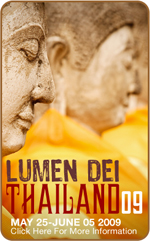 If you are lucky and can still get a spot you could be learning from some photographers who I really respect. Matt, David and Gavin are three guys who really know their stuff, as well as the often overlooked business side of travel photography. Anyway, in short hurry or book for next year, if it's possible.
If you are lucky and can still get a spot you could be learning from some photographers who I really respect. Matt, David and Gavin are three guys who really know their stuff, as well as the often overlooked business side of travel photography. Anyway, in short hurry or book for next year, if it's possible.
My images above: (Top) Fishermen preparing the nets before they go out to sea, Gokarna, Karnataka (Middle) A Brahmin (priest) outside a temple, Gokarna (Bottom) A scene at Malpe Harbour, Karnataka. Those marks in the sky are eagles and crows circling, looking for the odd fish to grab from the piles of what seemed to me like some sort of sea cockroaches.
 During one of our days in Kollam we wanted to find out where the "Beach Road" led to, so we decided to ride it south, as long as it followed the shoreline. After passing a couple of fishing villages and beaches we came to a corner, there the road branched off inland. A small shack stood on that corner, smoke was coming out of its windows and people with tea glasses stood outside. Having come to the end of the "Beach Road" and not having any desire to head back to our room, we got off the motorbike and went into the smoky shack. Inside I found one of my favorite photographic places in Kerala.
During one of our days in Kollam we wanted to find out where the "Beach Road" led to, so we decided to ride it south, as long as it followed the shoreline. After passing a couple of fishing villages and beaches we came to a corner, there the road branched off inland. A small shack stood on that corner, smoke was coming out of its windows and people with tea glasses stood outside. Having come to the end of the "Beach Road" and not having any desire to head back to our room, we got off the motorbike and went into the smoky shack. Inside I found one of my favorite photographic places in Kerala. One early Sunday morning I realized that no one goes to work on Sundays, no fishermen would be going out to the sea. Since I had already gotten up early I headed off to the tea-shack in hopes of catching some customers having tea there. This gentleman had just come from church and was reading the news with a glass of tea in his hand. I asked if I could photograph him, he smiled and agreed. Initially he stared directly into the camera, but I asked him to look a little to the side, to make the portrait more casual.
One early Sunday morning I realized that no one goes to work on Sundays, no fishermen would be going out to the sea. Since I had already gotten up early I headed off to the tea-shack in hopes of catching some customers having tea there. This gentleman had just come from church and was reading the news with a glass of tea in his hand. I asked if I could photograph him, he smiled and agreed. Initially he stared directly into the camera, but I asked him to look a little to the side, to make the portrait more casual. Anitha cooking parothas, while Manuel prepares them. Manuel managed to communicate to me that everyday they go through 400 parothas, no small task for a tiny place like theirs. This was taken through the window that sporadically expelled smoke from the cooking fire.
Anitha cooking parothas, while Manuel prepares them. Manuel managed to communicate to me that everyday they go through 400 parothas, no small task for a tiny place like theirs. This was taken through the window that sporadically expelled smoke from the cooking fire.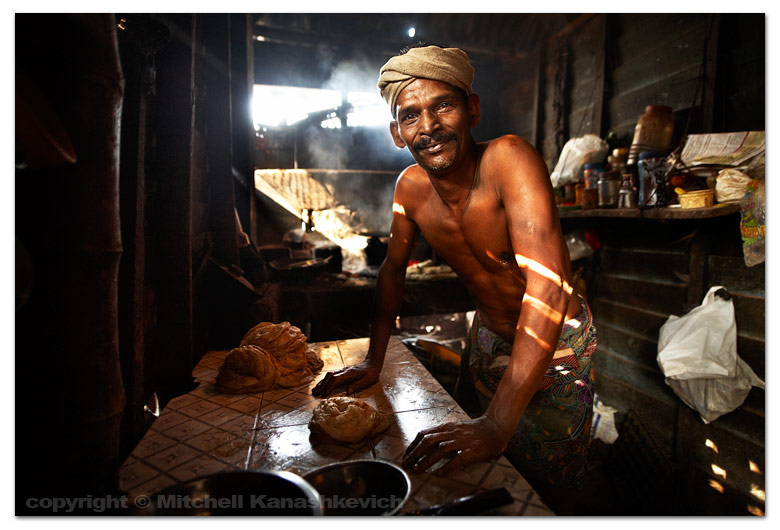 Manuel pauses while making parothas.
Manuel pauses while making parothas.


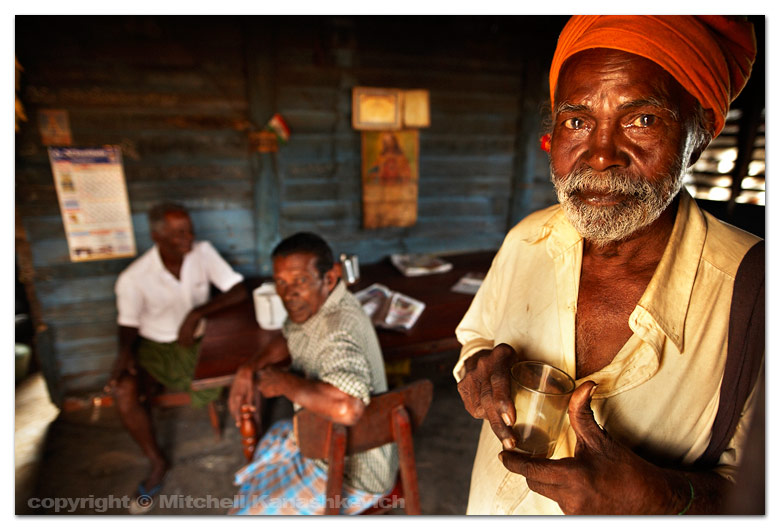


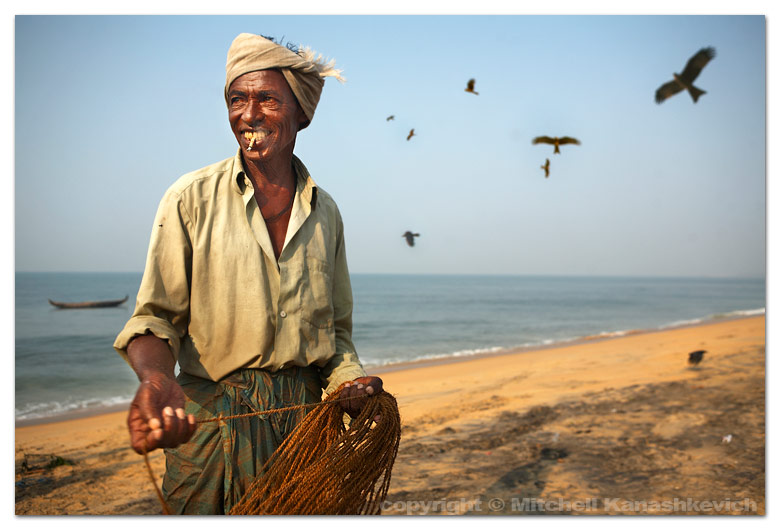




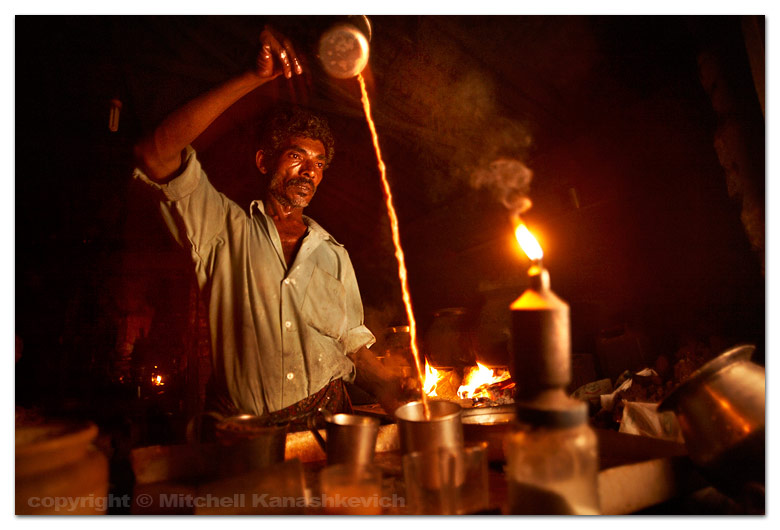



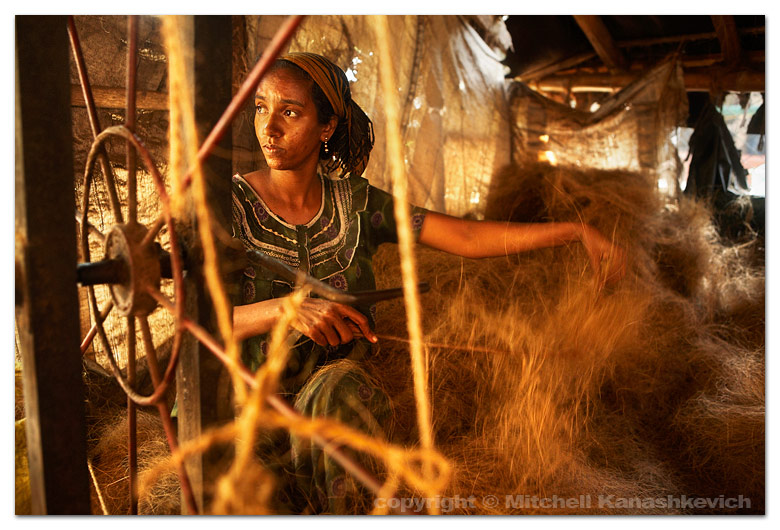
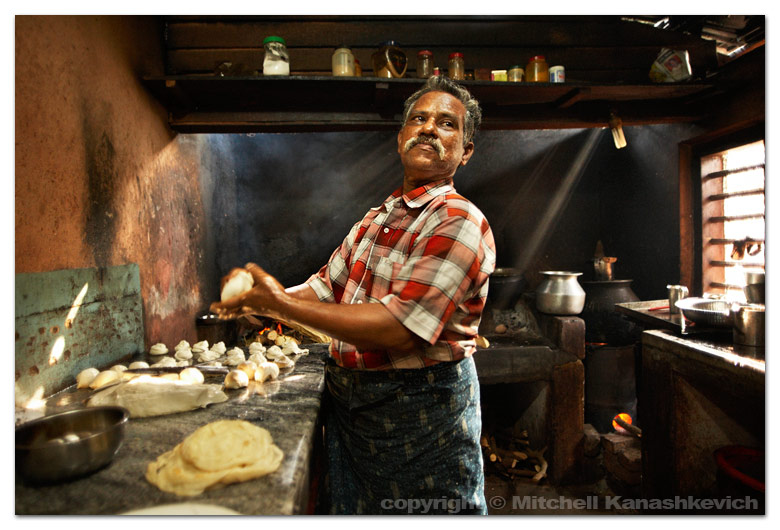
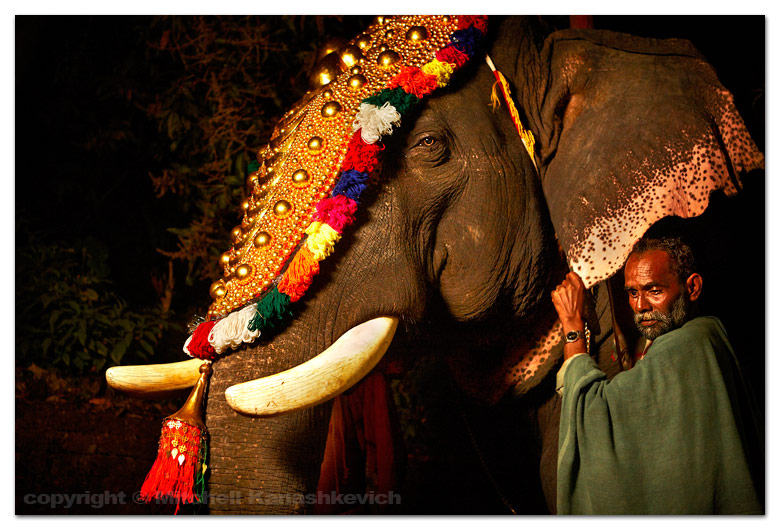


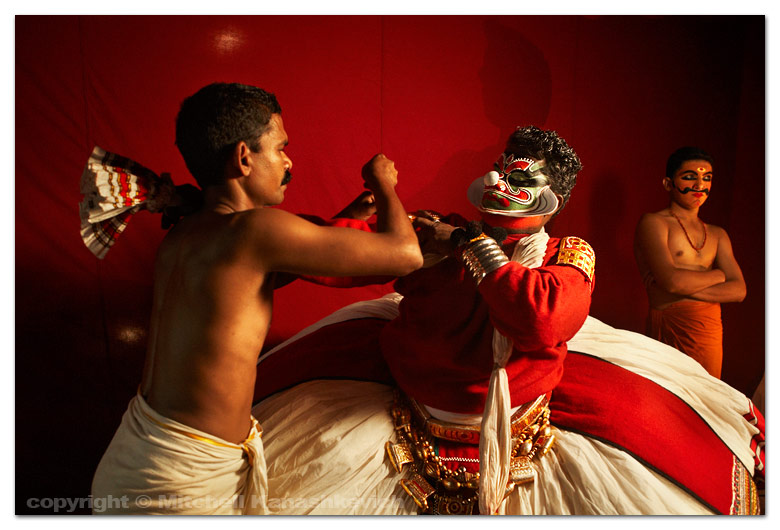
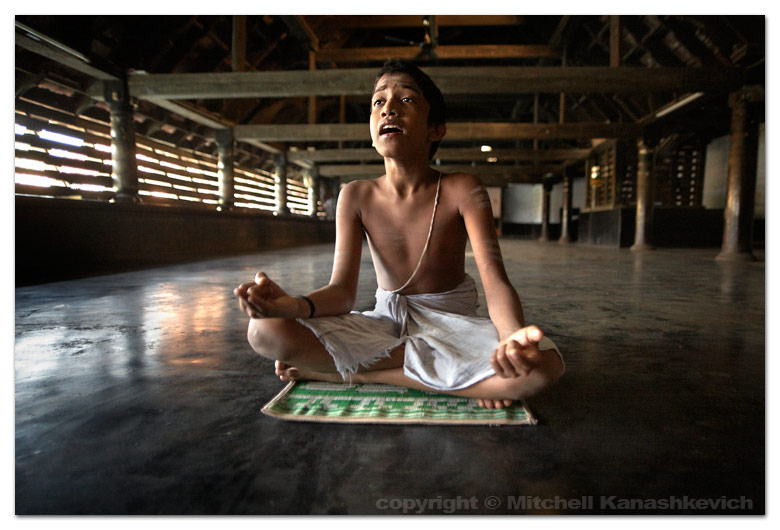


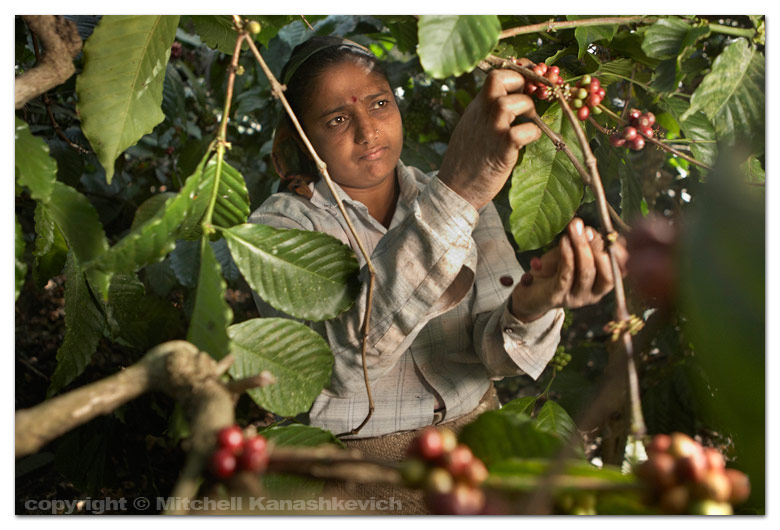
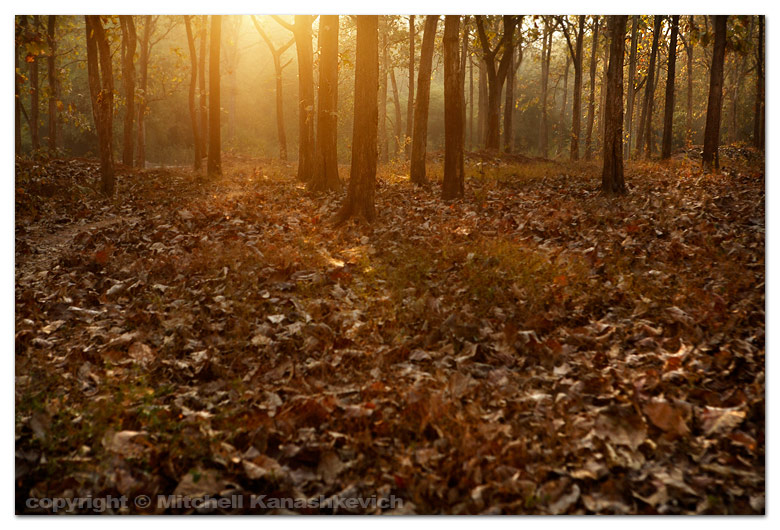

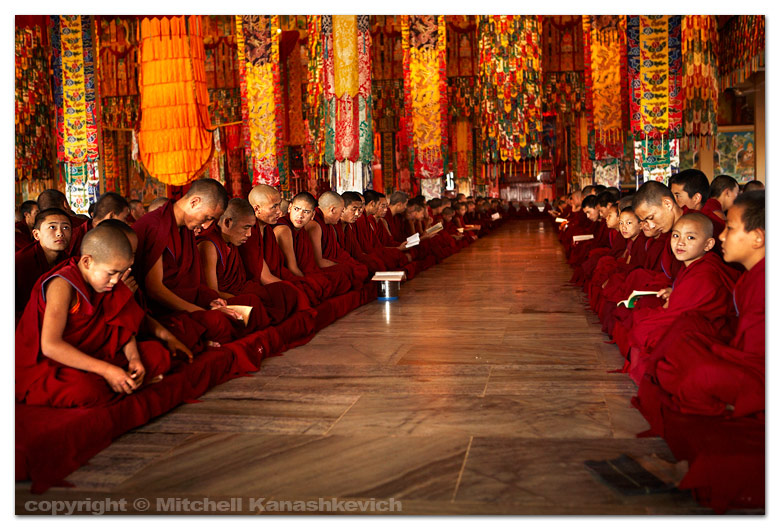

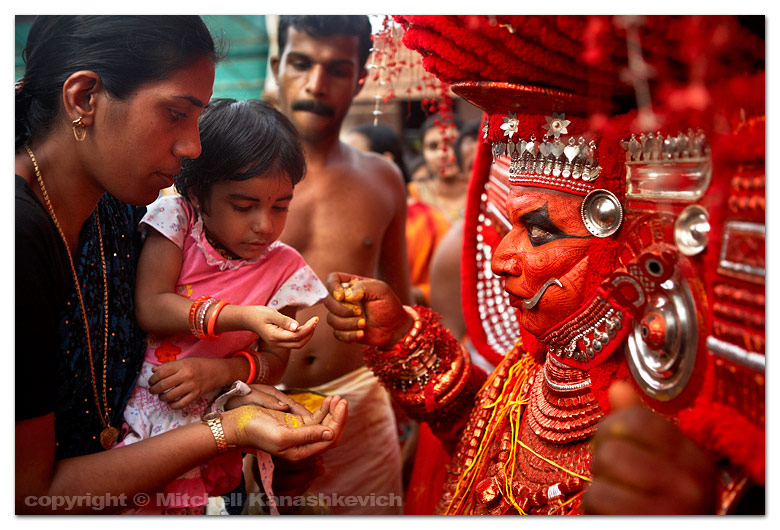 Photographing the Theyyam has been fascinating and frustrating. Fascinating because, well I think the images suggest why, and frustrating for several reasons. First there are crowds and then there are crowds of local photographers who battle for a good angle, not something I'm used to, since I rarely come across 'likeminded individuals' on my photographic quests. The next source of frustration comes from the fact that Theyyam is a deeply religious performance, in fact Theyyam means 'God' in the local language and so while the artist is performing he is basically a deity. When photographing such performances without much knowledge (learning on the spot from the fellow photographers who sometimes get reprimanded for pushing past anyone and anything) one has to tread carefully, not to offend anyone. Of course you could say that I could be better prepared and learn more about what I'm photographing, but not so. I have learned about the principal ideas and the history, however there are more than 400 Theyyam performances which are somewhat different from each other, not only that, the performances take place in different temples all the time and that means that the degree of restrictions is variable. On any given day I do not even know which Theyyam I'll be photographing.
Photographing the Theyyam has been fascinating and frustrating. Fascinating because, well I think the images suggest why, and frustrating for several reasons. First there are crowds and then there are crowds of local photographers who battle for a good angle, not something I'm used to, since I rarely come across 'likeminded individuals' on my photographic quests. The next source of frustration comes from the fact that Theyyam is a deeply religious performance, in fact Theyyam means 'God' in the local language and so while the artist is performing he is basically a deity. When photographing such performances without much knowledge (learning on the spot from the fellow photographers who sometimes get reprimanded for pushing past anyone and anything) one has to tread carefully, not to offend anyone. Of course you could say that I could be better prepared and learn more about what I'm photographing, but not so. I have learned about the principal ideas and the history, however there are more than 400 Theyyam performances which are somewhat different from each other, not only that, the performances take place in different temples all the time and that means that the degree of restrictions is variable. On any given day I do not even know which Theyyam I'll be photographing.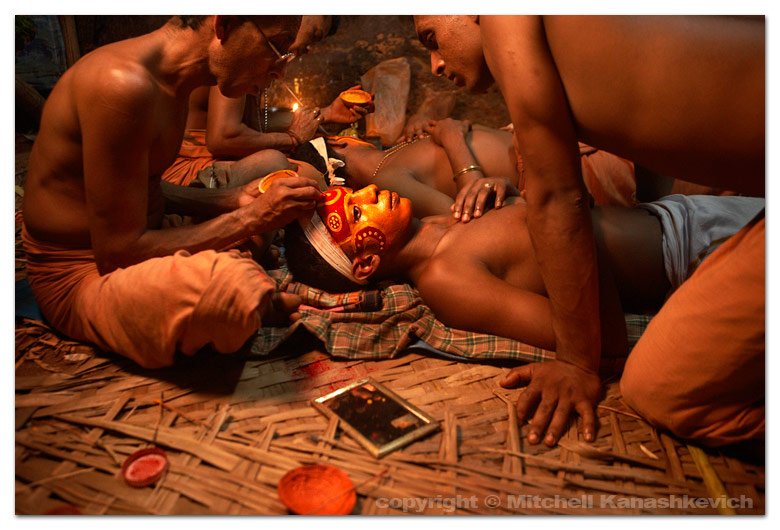
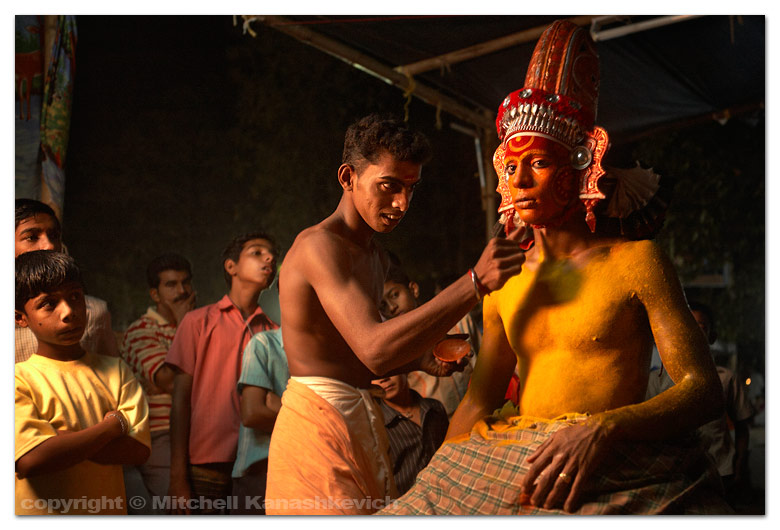 The first Theyyam the "Muhcilot" left me rather unimpressed, performance wise. In short it consisted of an elaborately dressed plump artist circling the temple and murmuring something in what I later found out to be a mixture of Sanskrit, Old Malayalam and Tamil (south Indian languages). Then the devotees rushed in, blessings were given and money started pouring in from all directions, so much money that it had to be put into baskets to be carried away. This went on for over two hours and as I later found out (I couldn't bear staying any longer) it would go into the night, until all of the devotees were blessed.
The first Theyyam the "Muhcilot" left me rather unimpressed, performance wise. In short it consisted of an elaborately dressed plump artist circling the temple and murmuring something in what I later found out to be a mixture of Sanskrit, Old Malayalam and Tamil (south Indian languages). Then the devotees rushed in, blessings were given and money started pouring in from all directions, so much money that it had to be put into baskets to be carried away. This went on for over two hours and as I later found out (I couldn't bear staying any longer) it would go into the night, until all of the devotees were blessed.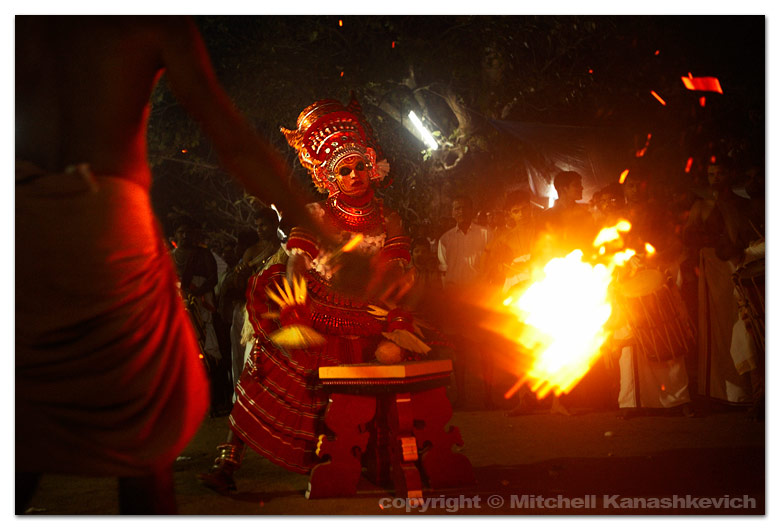
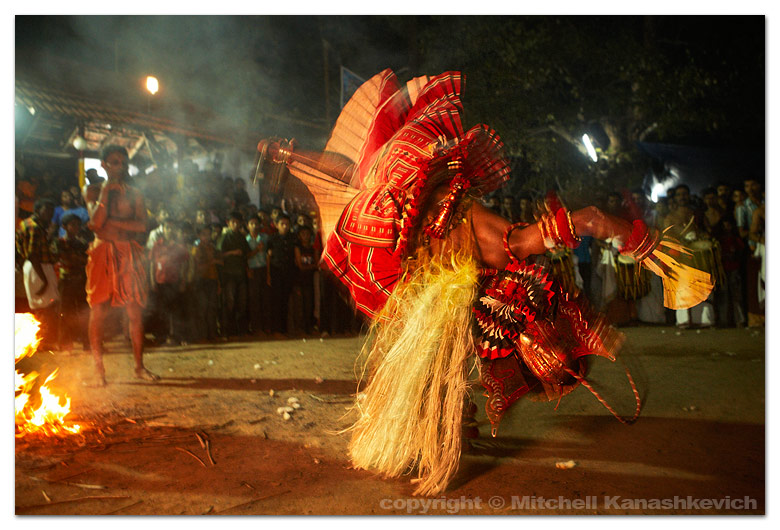 The second Theyyam was the same as the first and rather than watch it I decided to head to the Kerala Folklore Academy, to learn whether there was more to Theyyam than what I had seen. The photos on the walls of their small museum and a very brief conversation with a very-busy-overtime-working Theyyam expert left me with the belief that indeed there was much more to Theyyam. The very next night I would see just how much more. Upon arriving at another village temple I unknowingly befriended a young Theyyam artist who spoke basic English. When I found out who he was and who the small group of young men with him were (all Theyyam artists) I asked if I could photograph them while they put on their makeup and get dressed, they agreed. I photographed the whole process and then, suddenly the temple drummers began to beat a dramatic tune, the last elements of the costume were in place and the artist, as if possessed by a wild beast, jumped from his make up chair and rushed into the temple. His performance would be a stark contrast to the monotonous stuff I had seen earlier. There was fast, loud, dramatic drumming, fire, summersaults and cartwheels. The next Theyyam performance was even more impressive, with more of the same content, executed in an even more dramatic manner. The whole thing was pretty amazing, the atmosphere, the crowd's reaction and of course the Theyyam itself. Tanya and I definitely felt the magic in the air.
The second Theyyam was the same as the first and rather than watch it I decided to head to the Kerala Folklore Academy, to learn whether there was more to Theyyam than what I had seen. The photos on the walls of their small museum and a very brief conversation with a very-busy-overtime-working Theyyam expert left me with the belief that indeed there was much more to Theyyam. The very next night I would see just how much more. Upon arriving at another village temple I unknowingly befriended a young Theyyam artist who spoke basic English. When I found out who he was and who the small group of young men with him were (all Theyyam artists) I asked if I could photograph them while they put on their makeup and get dressed, they agreed. I photographed the whole process and then, suddenly the temple drummers began to beat a dramatic tune, the last elements of the costume were in place and the artist, as if possessed by a wild beast, jumped from his make up chair and rushed into the temple. His performance would be a stark contrast to the monotonous stuff I had seen earlier. There was fast, loud, dramatic drumming, fire, summersaults and cartwheels. The next Theyyam performance was even more impressive, with more of the same content, executed in an even more dramatic manner. The whole thing was pretty amazing, the atmosphere, the crowd's reaction and of course the Theyyam itself. Tanya and I definitely felt the magic in the air.




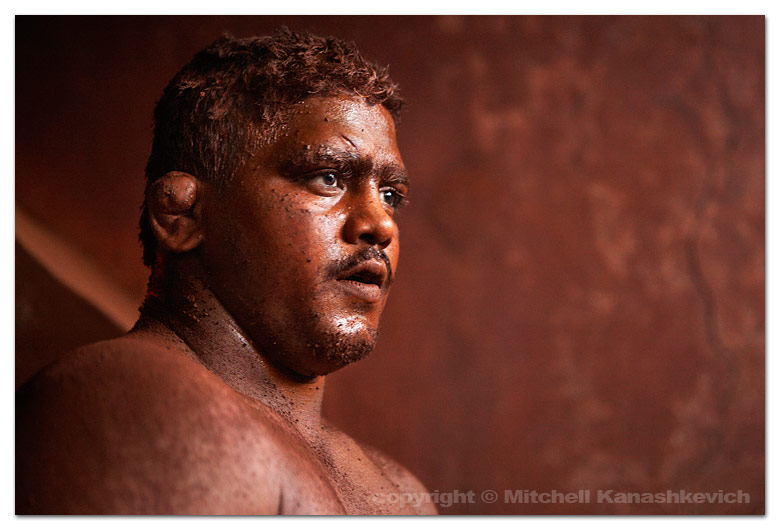
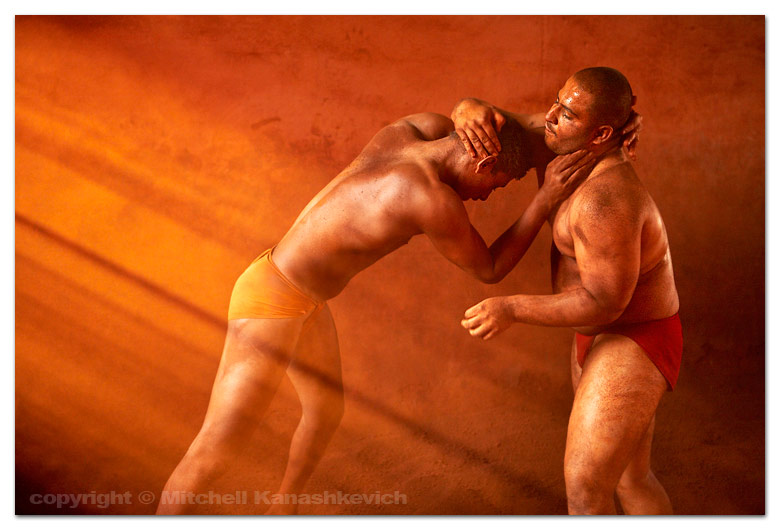

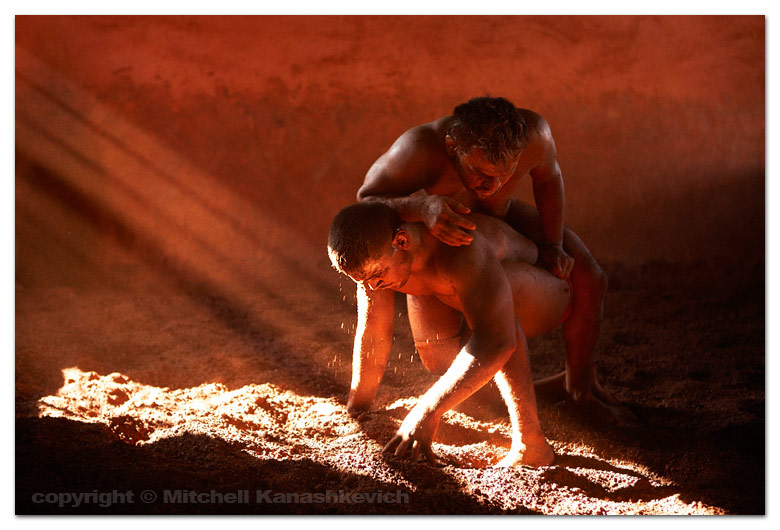

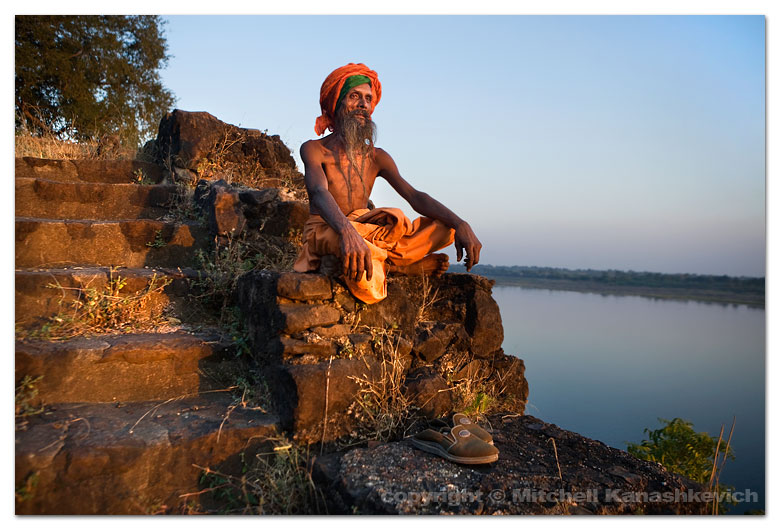 The last ten or so days have been intense. We have covered over 1000km of road, sometimes extremely bad road, pot-holed, narrow and full of half-competent drivers. But riding on these kinds of roads often brings unexpected amusement. Close to the Madhya Pradesh/Rajasthan border we came across a 'holy man'. He had obviously been walking along the road for a long time, but he was being followed by an entourage - people with sun-blocking umbrellas and cars with large signs promoting his pilgrimage. Not so unusual for India, except for the fact that the man was completely naked.Less than one hundred kilometers later we were treated to a sighting of an almost literal clash of two worlds - the ancient and the modern. A caravan of bejeweled tribal women with camels and children (most of them on top of the camels) crossed the road as cars and trucks moving at insane speeds somehow managed to slow down in time not to run anyone over.
Our first stop was Ujjain - a place of pilgrimage that holds a great significance for Hindus around India. Every twelve years it hosts what is possibly the largest gathering of humans on earth - the Kubh Mela. The next mela is eight years away, so the city was rather subdued when we visited. Ujjain offers a glimpse of the exotic Hindu India that we often see on TV and in picture books. Every morning devotees bathe in the holy waters of the Shipra river, they wash away their sins and make offerings. The Brahmins (priests) at the riverside temples perform various religious ceremonies, the way their ancestors have for hundreds of years, the only difference now seems to be the priests' short attention span, evident from their constant checking of the mobile phone right in the middle of the ceremonies.
Our next stop at the small town of Maheshwar by the Narmada river, was meant to last for a day and a morning, but once we felt the peaceful rhythm of life here and the warmth of the locals, we got 'sucked' in and stayed three days. Maheshwar is also a place for religious pilgrimage, but it is much, much lower scale. It is what I imagine India was like a long time ago, before the whole modernization and population explosion occurred. There is definitely magic in the air, perhaps because it hasn't yet been killed by the blaring sounds from stereo systems and the large rubbish throwing crowds, so common around similar places. A walk along the riverside in Maheshwar is one of the most serene experiences one is likely to have in India and a swim in the Narmada river here at sunset is like nothing else (yes, I braved it and went in, but Narmada is not as polluted as India's other rivers). Floating in the water and seeing the huge fort and the numerous temples towering above, while the setting sun’s rays painted everything gold felt absolutely surreal.
We would have liked to stay longer in Maheshwar, but at this stage time is not a luxury we possess. Our stop at Nasik (another Kumbh Mela destination) was brief, but the next one at Pune was longer than expected. Not that I am complaining, since Pune turned out to be quite fascinating for a place where I didn't even think about photographing, but more of that in the next post.
I am posting some images from Maheshwar. The first two (one at the top one below) are of a Sadhu we met at a small, isolated temple on a hill overlooking the Narmada. Sadhus are also known as holy men, ascetics and saints in India. In reality they are often very far from anything holy or spiritual. Most that I had come across were simply wanderers, beggars and in worst cases scam artists, in fact I am always cautious when a Sadhu asks me to come over and speak with him. Usually any conversation simply leads to how I should give him money, but there are also plenty of stories of naive travelers being drugged, robbed and having other not so nice things happen to them. If I am in famous pilgrimage places full of tourists I will not even waste my time, but here I was in Maheshwar (which only seems to get a trickle of visitors) and this Sadhu gestured with his hand from his temple for me and my wife to come up. While the isolated location seemed like an ideal place for something bad to happen we decided to go, we simply wouldn't drink or eat anything offered to us, paranoid maybe, but safe. The Sadhu spoke less English than I spoke Hindi and that is about 20 words. Our conversation revealed which pilgrimage places he had been to (very many). He had many children and whether they were biological or spiritual was not easy to understand, but they did live all over the world. Suddenly he got me to right down an address, which turned into a collection of random names and places in different countries. His children maybe? Finally I managed to communicate that I wanted to photograph him by the window of his room, he agreed, I asked if he could smoke his chillum (the pipe used to smoke opium) he did. There wasn't quite enough light in the room to photograph without setting the shutter speed too low, so again Tanya helped with the flash from the window side, used in a softbox at 1/64 of the power. The next image was taken outside of the Sadhu's temple. The sun was setting and the location seemed perfect, with the Narmada in the background. After the little photo session the Sadhu invited us to follow him somewhere, just for five minutes. We got a bit worried, as that's how those horror stories usually started, but again decided to take the risk. At this stage the Sadhu's nature seemed quite friendly, even if a little mad. We followed along a narrow path surrounded by vegetation and ended up at what seemed like another temple and a small room. There were houses with people nearby and one young man spoke some English. I asked him whether the Sadhu wanted us to come with him for some particular reason. – No, he just wanted to offer you food and milk, just ‘time pass’. It really didn’t seem like the Sadhu had too much to offer, so we politely declined and instead took down the address of his temple, to send him the photographs.
The last ten or so days have been intense. We have covered over 1000km of road, sometimes extremely bad road, pot-holed, narrow and full of half-competent drivers. But riding on these kinds of roads often brings unexpected amusement. Close to the Madhya Pradesh/Rajasthan border we came across a 'holy man'. He had obviously been walking along the road for a long time, but he was being followed by an entourage - people with sun-blocking umbrellas and cars with large signs promoting his pilgrimage. Not so unusual for India, except for the fact that the man was completely naked.Less than one hundred kilometers later we were treated to a sighting of an almost literal clash of two worlds - the ancient and the modern. A caravan of bejeweled tribal women with camels and children (most of them on top of the camels) crossed the road as cars and trucks moving at insane speeds somehow managed to slow down in time not to run anyone over.
Our first stop was Ujjain - a place of pilgrimage that holds a great significance for Hindus around India. Every twelve years it hosts what is possibly the largest gathering of humans on earth - the Kubh Mela. The next mela is eight years away, so the city was rather subdued when we visited. Ujjain offers a glimpse of the exotic Hindu India that we often see on TV and in picture books. Every morning devotees bathe in the holy waters of the Shipra river, they wash away their sins and make offerings. The Brahmins (priests) at the riverside temples perform various religious ceremonies, the way their ancestors have for hundreds of years, the only difference now seems to be the priests' short attention span, evident from their constant checking of the mobile phone right in the middle of the ceremonies.
Our next stop at the small town of Maheshwar by the Narmada river, was meant to last for a day and a morning, but once we felt the peaceful rhythm of life here and the warmth of the locals, we got 'sucked' in and stayed three days. Maheshwar is also a place for religious pilgrimage, but it is much, much lower scale. It is what I imagine India was like a long time ago, before the whole modernization and population explosion occurred. There is definitely magic in the air, perhaps because it hasn't yet been killed by the blaring sounds from stereo systems and the large rubbish throwing crowds, so common around similar places. A walk along the riverside in Maheshwar is one of the most serene experiences one is likely to have in India and a swim in the Narmada river here at sunset is like nothing else (yes, I braved it and went in, but Narmada is not as polluted as India's other rivers). Floating in the water and seeing the huge fort and the numerous temples towering above, while the setting sun’s rays painted everything gold felt absolutely surreal.
We would have liked to stay longer in Maheshwar, but at this stage time is not a luxury we possess. Our stop at Nasik (another Kumbh Mela destination) was brief, but the next one at Pune was longer than expected. Not that I am complaining, since Pune turned out to be quite fascinating for a place where I didn't even think about photographing, but more of that in the next post.
I am posting some images from Maheshwar. The first two (one at the top one below) are of a Sadhu we met at a small, isolated temple on a hill overlooking the Narmada. Sadhus are also known as holy men, ascetics and saints in India. In reality they are often very far from anything holy or spiritual. Most that I had come across were simply wanderers, beggars and in worst cases scam artists, in fact I am always cautious when a Sadhu asks me to come over and speak with him. Usually any conversation simply leads to how I should give him money, but there are also plenty of stories of naive travelers being drugged, robbed and having other not so nice things happen to them. If I am in famous pilgrimage places full of tourists I will not even waste my time, but here I was in Maheshwar (which only seems to get a trickle of visitors) and this Sadhu gestured with his hand from his temple for me and my wife to come up. While the isolated location seemed like an ideal place for something bad to happen we decided to go, we simply wouldn't drink or eat anything offered to us, paranoid maybe, but safe. The Sadhu spoke less English than I spoke Hindi and that is about 20 words. Our conversation revealed which pilgrimage places he had been to (very many). He had many children and whether they were biological or spiritual was not easy to understand, but they did live all over the world. Suddenly he got me to right down an address, which turned into a collection of random names and places in different countries. His children maybe? Finally I managed to communicate that I wanted to photograph him by the window of his room, he agreed, I asked if he could smoke his chillum (the pipe used to smoke opium) he did. There wasn't quite enough light in the room to photograph without setting the shutter speed too low, so again Tanya helped with the flash from the window side, used in a softbox at 1/64 of the power. The next image was taken outside of the Sadhu's temple. The sun was setting and the location seemed perfect, with the Narmada in the background. After the little photo session the Sadhu invited us to follow him somewhere, just for five minutes. We got a bit worried, as that's how those horror stories usually started, but again decided to take the risk. At this stage the Sadhu's nature seemed quite friendly, even if a little mad. We followed along a narrow path surrounded by vegetation and ended up at what seemed like another temple and a small room. There were houses with people nearby and one young man spoke some English. I asked him whether the Sadhu wanted us to come with him for some particular reason. – No, he just wanted to offer you food and milk, just ‘time pass’. It really didn’t seem like the Sadhu had too much to offer, so we politely declined and instead took down the address of his temple, to send him the photographs.
